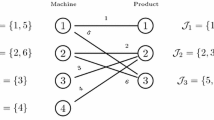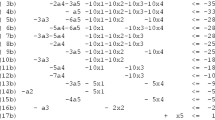Abstract
This paper develops and tests an efficient mixed integer programming model for capacitated lot sizing and scheduling with non-triangular and sequence-dependent setup times and costs incorporating all necessary features of setup carryover and overlap** on different machine configurations. The model’s formulation is based on the asymmetric travelling salesman problem and allows multiple lots of a product within a period. The model conserves the setup state when no product is being processed over successive periods, allows starting a setup in a period and ending it in the next period, permits ending a setup in a period and starting production in the next period(s), and enforces a minimum lot size over multiple periods. This new comprehensive model thus relaxes all limitations of physical separation between the periods. The model is first developed for a single machine and then extended to other machine configurations, including parallel machines and flexible flow lines. Computational tests demonstrate the flexibility and comprehensiveness of the proposed models.







Similar content being viewed by others
References
Almada-Lobo B, Klabjan D, Carravilla MA, Oliveira J (2007) Single machine multi-product capacitated lot sizing with sequence-dependent setups. Int J Prod Res 45:4873–4894
Belo-Filho MAF, Toledo FMB, Almada-Lobo B (2013) Models for capacitated lot-sizing problem with backlogging, setup carryover and crossover. J Oper Res Soc 65:1735–1747
Bitran GR, Yanasse HH (1982) Computational complexity of the capacitated lot size problem. Manag Sci 28:1174–1186
Brooke A, Kendrick D, Meeraus A (1988) GAMS. General algebraic modeling system, a user guide. The Scientific Press, South San Francisco
Clark AR, Clark SJ (2000) Rolling-horizon lot-sizing when set-up times are sequence-dependent. Int J Prod Res 38:2287–2307
Clark AR, Morabito R, Toso EAV (2010) Production setup-sequencing and lot-sizing at an animal nutrition plant through ATSP subtour elimination and patching. J Sched 13:111–121
Clark A, Mahdieh M, Rangel S (2014) Production lot sizing and scheduling with non-triangular sequence-dependent setup times. Int J Prod Res 52(8):2490–2503
Claus A (1984) A new formulation for the travelling salesman problem. SIAM J Algebraic Discrete Methods 5:21
Copil K, Worbelauer M, Meyr H, Tempelmeier H (2016) Simultaneous lotsizing and scheduling problems: a classification and review of models. OR Spectrum 39(1):1–64
CPLEX (2014) Software package, CPLEX. 12.6. New York, USA
Desrochers M, Laporte G (1991) Improvements and extensions to the Miller–Tucker–Zemlin subtour elimination constraints. Oper Res Lett 10:27–36
Eppen GD, Martin RK (1987) Solving multi-item capacitated lot-sizing problems using variable redefinition. Oper Res 35(6):832–848
Fleischmann B (1990) The discrete lot-sizing and scheduling problem. Eur J Oper Res 44:337–348
Fleischmann B, Meyr H (1997) The general lotsizing and scheduling problem. OR Spectrum 19:11–21
Gopalakrishnan M (2000) A modified framework for modelling set-up carryover in the capacitated lotsizing problem. Int J Prod Res 38:3421–3424
Gopalakrishnan M, Miller DM, Schmidt CP (1995) A framework for modelling setup carryover in the capacitated lot sizing problem. Int J Prod Res 33:1973–1988
Gopalakrishnan M, Ding K, Bourjolly JM, Mohan S (2001) A tabu-search heuristic for the capacitated lot-sizing problem with set-up carryover. Manag Sci 47(6):851–863
Guimaraes L, Klabjan D, Almada-Lobo B (2014) Modeling lotsizing and scheduling problems with sequence dependent setups. Eur J Oper Res 239:644–662
Günther H-O (2014) The block planning approach for continuous time-based dynamic lot sizing and scheduling. Bus Res 7:51–76
Günther HO, Grunow M, Neuhaus U (2006) Realizing block planning concepts in make-and-pack production using MILP modelling and SAP APO©. Int J Prod Res 44:3711–3726
Gupta D, Magnusson T (2005) The capacitated lot-sizing and scheduling problem with sequence-dependent setup costs and setup times. Comput Oper Res 32:727–747
Haase K (1996) Capacitated lot-sizing with sequence dependent setup costs. OR Spectrum 18:51–59
Haase K, Kimms A (2000) Lot sizing and scheduling with sequence-dependent setup costs and times and efficient rescheduling opportunities. Int J Prod Econ 66:159–169
Karimi B, Fatemi Ghomi SMT, Wilson JM (2003) The capacitated lot sizing problem: a review of models and algorithms. Omega 31:365–378
Koçlar A (2005) The general lot sizing and scheduling problem with sequence dependent changeovers. Middle East Technical University
Koçlar A, Süral H (2005) A note on “The general lot sizing and scheduling problem”. OR Spectrum 27:145–146
Laporte G (1992a) Traveling salesman problem: an overview of exact and approximate algorithms. Eur J Oper Res 59:231–247
Laporte G (1992b) The vehicle routing problem: an overview of exact and approximate algorithms. Eur J Oper Res 59:345–358
Menezes AA, Clark A, Almada-Lobo B (2011) Capacitated lot-sizing and scheduling with sequence-dependent, period-overlap** and non-triangular setups. J Sched 14:209–219
Meyr H (2000) Simultaneous lotsizing and scheduling by combining local search with dual reoptimization. Eur J Oper Res 120:311–326
Meyr H (2002) Simultaneous lotsizing and scheduling on parallel machines. Eur J Oper Res 139:277–292
Özdamar L, Barbarosoğlu G (1999) Hybrid heuristics for the multi-stage capacitated lot sizing and loading problem. J Oper Res Soc 50:810–825
Porkka P, Vepsalainen APJ, Kuula M (2003) Multiperiod production planning carrying over set-up time. Int J Prod Res 41:1133–1148
Salomon M (1991) Deterministic lotsizing models for production planning. Lecture notes in economics and mathematical systems. Springer, Berlin
Salomon M, Kroon LG, Kuik R, Van Wassenhove LN (1991) Some extensions of the discrete lotsizing and scheduling problem. Manag Sci 37:801–812
Salomon M, Solomon MM, Van Wassenhove LN, Dumas Y, Dauzère-Pérès S (1997) Solving the discrete lotsizing and scheduling problem with sequence dependent set-up costs and set-up times using the travelling salesman problem with time windows. Eur J Oper Res 100:494–513
Sarin SC, Sherali HD, Yao L (2011) New formulation for the high multiplicity asymmetric traveling salesman problem with application to the Chesapeake problem. Optim Lett 5:259–272
Sox CR, Gao Y (1999) The capacitated lot sizing problem with setup carry-over. IIE Trans 31:173–181
Suerie C (2006) Modeling of period overlap** setup times. Eur J Oper Res 174:874–886
Suerie C, Stadtler H (2003) The capacitated lot-sizing problem with linked lot sizes. Manag Sci 49(8):1039–1054
Sung C, Maravelias CT (2008) A mixed-integer programming formulation for the general capacitated lot-sizing problem. Comput Chem Eng 32:244–259
Author information
Authors and Affiliations
Corresponding author
Appendices
Appendix 1: MLOV-SM model
Appendix 2: ML-PM model
Appendix 3: MLOV-PM model
Appendix 4: ML-FFL model
Appendix 5: MLOV-FFL model
Rights and permissions
About this article
Cite this article
Mahdieh, M., Clark, A. & Bijari, M. A novel flexible model for lot sizing and scheduling with non-triangular, period overlap** and carryover setups in different machine configurations. Flex Serv Manuf J 30, 884–923 (2018). https://doi.org/10.1007/s10696-017-9279-5
Published:
Issue Date:
DOI: https://doi.org/10.1007/s10696-017-9279-5




